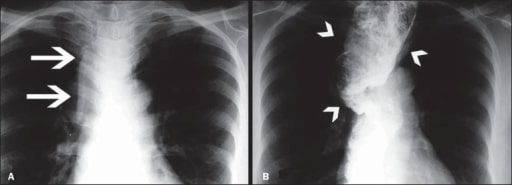Playlist
Show Playlist
Hide Playlist
Achalasia with Case
-
Slides Gastroenterology 05 Esophageal Diseases.pdf
-
Reference List Gastroenterology.pdf
-
Download Lecture Overview
00:00 Let's move on to our next case. 00:02 We have a 62-year-old woman who presents to clinic complaining of intermittent difficulty with swallowing for the past five years. 00:10 She has trouble with both solids and liquids. 00:12 And in the last two months she has noted that she frequently regurgitates undigested food and is losing weight. 00:18 Her vitals are normal. 00:20 Oropharynx and abdominal exams unremarkable and labs are normal. 00:25 A barium swallow study is shown here. 00:28 So, what is the most likely diagnosis? Before we answer that, let's look at some key features. 00:34 She has chronic intermittent dysphagia to both solid and liquids, she regurgitates food frequently and has weight loss, and her barium swallow shows this typical bird's beak appearance. 00:50 So, let's talk about the diagnosis of achalasia. 00:56 Achalasia happens when there's failure of the lower esophageal sphincter to relax with swallowing. 01:02 And then in addition to that, the esophagus does not contract. 01:06 So that's called aperistalsis of the esophagus. 01:09 It can be from many causes including idiopathic where we just don't know why it forms, they may have gastric cancer, or Chagas disease leading to this condition. 01:21 Patients may present with dysphagia to both solids and liquids, they may frequently regurgitate food, they may have chest pain, weight loss, and frequent aspiration. 01:32 Here you can see the example of the normal esophagus where the lower esophageal sphincter relaxes with swallowing. 01:38 On the right side of this diagram you see an abnormal esophagus where the lower esophageal sphincter fails to relax and then the esophagus proximal to that dilates because it has nowhere else to go. 01:50 So, the diagnosis is made by a barium swallow. 01:53 You may also do an upper endoscopy to rule out mechanical obstruction or cancer or you may do esophageal manometry to measure the pressure inside the esophagus and confirm the diagnosis. 02:07 Here on the right you can see that typical bird's beak appearance on a barium swallow where there is retained contrast in the esophagus which looks large and dilated and then it tapers to a fine point where the lower esophageal sphincter is failing to relax. 02:22 You wanna treat these patients with botulinum toxin injection we can help -- which can help relax the lower esophageal sphincter. You may also do endoscopic dilation or surgical myotomy. 02:34 So now let's return to our case. 02:38 Our 62-year-old woman who has chronic intermittent dysphagia to both solids and liquids, regurgitation, weight loss, and this typical bird's beak appearance on her barium swallow. 02:49 So, the dysphagia to both solids and liquids points to a motility disorder. 02:54 And her regurgitation and weight loss may prompt you to consider esophageal diverticula or a diagnosis of achalasia. 03:02 In this case because of her barium swallow you should think of a diagnosis of achalasia.
About the Lecture
The lecture Achalasia with Case by Kelley Chuang, MD is from the course Disorders of the Esophagus and the Stomach.
Included Quiz Questions
Which of the following best describes achalasia?
- Aperistalsis of the esophagus and increased resting tone of the lower esophageal sphincter
- Aperistalsis of the esophagus and decreased resting tone of the lower esophageal sphincter
- Normal peristalsis of the esophagus and increased resting tone of the lower esophageal sphincter
- Normal peristalsis of the esophagus and decreased resting tone of the lower esophageal sphincter
- Normal peristalsis of the esophagus and normal resting tone of the lower esophageal sphincter
Which of the following is used to confirm the diagnosis of achalasia?
- Manometry
- Upper endoscopy
- Barium swallow
- Surgical myotomy
- Endoscopic dilation
Customer reviews
5,0 of 5 stars
| 5 Stars |
|
5 |
| 4 Stars |
|
0 |
| 3 Stars |
|
0 |
| 2 Stars |
|
0 |
| 1 Star |
|
0 |





